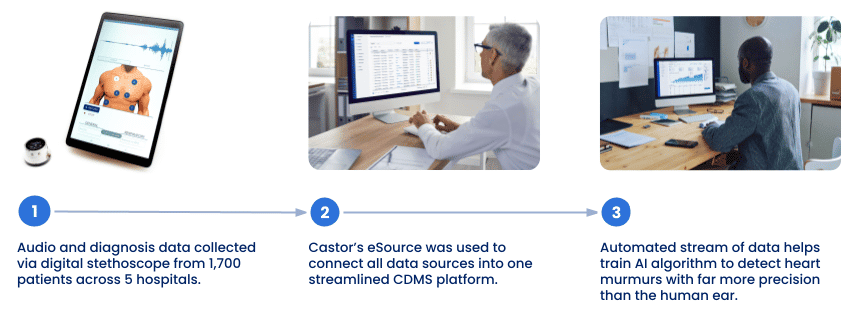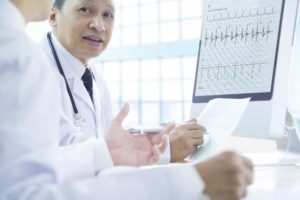AusculThing’s AI algorithm is positioned to completely transform the way health care providers detect heart murmurs, enabling them with a far more precise tool than the human ear. Although, to train the algorithm to work more effectively, they would need to collect an enormous amount of data from over 1,700 patients across 5 sites.
Reinventing heart and lung sound readings
Auscultation is traditionally a manual process, where a doctor, nurse or healthcare provider listens to the sounds of the body during a physical exam, and makes a recommendation or referral to a specialist based on what they hear. This process is highly subjective – what one provider hears may not be the same as another. Also, conducting an accurate auscultation reading requires years of experience, a very trained ear, and an incredible amount of skill. Inaccurate auscultation readings have the potential to completely overwhelm public healthcare systems, and even more critically, have dire consequences for patients that need specialty care.
AusculThing is a software company that’s positioned to take the subjectiveness out of auscultation, and create a standardized method for analyzing heart and lung sound readings using AI. Based on data signals, AusculThing can train their AI to detect heart murmurs with exponentially more precision than the subjective ear of a human health care provider. With an objective and accurate way for primary care providers to make referrals based on auscultation, the right patients will see heart and lung specialists and receive the timely care they need.
This AI algorithm has the potential to create incredible efficiencies for healthcare systems worldwide, but before being deployed at scale, it would need a steady and significant stream of data to become more accurate and prove its efficacy in a clinical setting.
Building an app for providers to collect data across multiple sites
AusculThing’s software processes audio recordings collected by a digital stethoscope called the ACC sensor. AusculThing built a provider-facing mobile app that would automate the collection of ACC sensor data from 5 university hospitals into one streamlined interface. Audio data recorded by the digital stethoscope and additional diagnosis info from over 1,700 patients was logged into the app by providers at each hospital, and pushed directly into Castor’s decentralized clinical data platform without the need for manual source data verification.

Navigating large data collection in a fast-paced environment

Using Castor was very simple for the nurses and care providers involved in AusculThing’s study. They could easily use the platform to enter diagnoses data without much training or technical knowledge. This was incredibly helpful to ensure that data entry wasn’t an added burden for healthcare providers on the frontlines.
“We try to make our data workflow from the clinical setting to us as smooth as possible. Here, Castor’s eSource played a very important role, because it provided us the possibility to program our own application with a custom user interface that’s very easy to use. Now, with Castor, there’s no barrier for using the system.”
– Martin Porkholm, Chief Information Officer, AusculThing
Creating healthy data flow with eSource

Castor’s eSource platform enabled AusculThing to collect, capture, and process a significant amount of patient data from several sources, scale data collection as their needs evolved, and eliminate manual source data verification. With data that’s healthy, integrated, and accessible through one interface, AusculThing can now train their AI algorithm much more efficiently, and make considerable strides in creating an auscultation system that’s more accurate and efficient for healthcare systems worldwide.